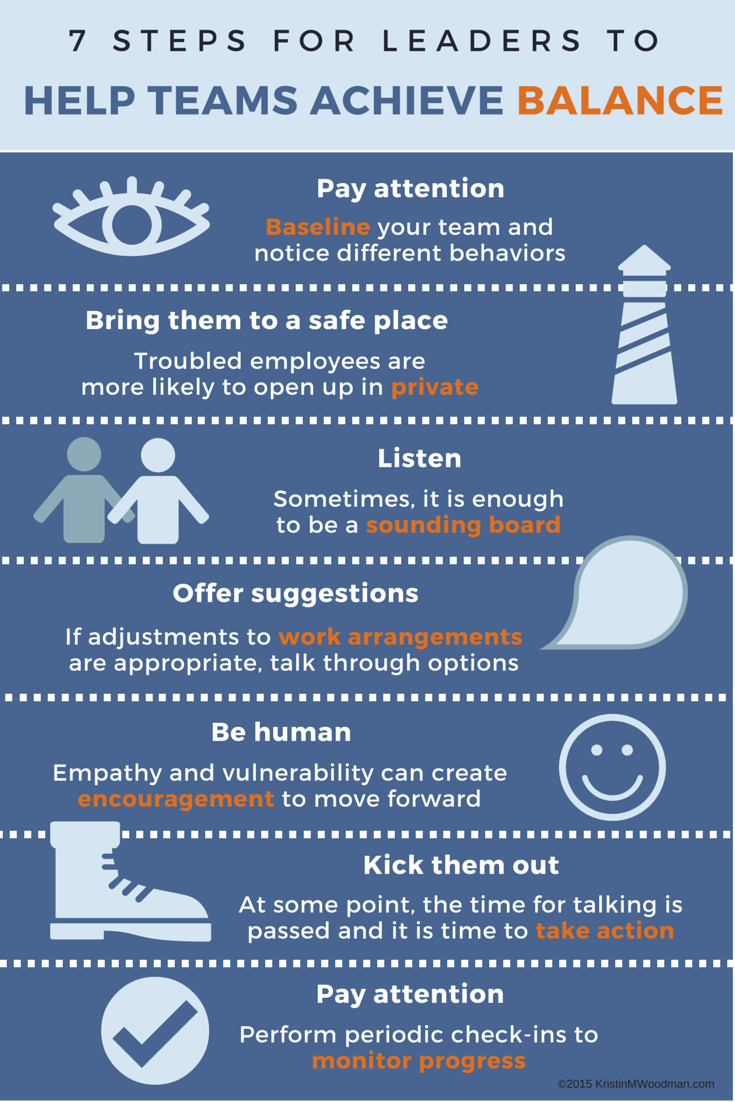
Every year, like many companies, our organization conducts an employee opinion survey. This year, I volunteered to lead a working team on Work Life Balance, an area that frequently receives a lot of attention.
We found that Work Life Balance is very much a personal choice. What it meant to me was different than what it meant to others on the team. Having a flexible work environment helps, of course, but then it’s up to the employee to determine how to best balance the demands of home and work and set reasonable expectations for both.
But what about when life or work is not reasonable? There are times when the demands of one or the other become overwhelming. Though the individual has ultimate responsibility for his or her life choices, as leaders we have the opportunity to help guide and support them through those choices. By helping our team members navigate the rough spots, we can help them get back to a place of balance, which can improve productivity.
As leaders, how can we help?

1. Pay attention
This may seem obvious, but is frequently overlooked. Often, a team doesn’t tell its leader when something is wrong. For the most part, they will put a good face on things. The entire team may know that someone’s life is in chaos, but unless leaders are out on the floor near their team, they will likely be the last to know.
How do leaders figure out what’s going on if no one is talking to them? Developing a baseline can help leaders realize when something is not quite right. Connecting with people, such as through management by walking around (MBWA), is key to creating that baseline.
For example, if most days a team member greets everyone with a smile, notice the day she doesn’t.
2. Bring them to “Vegas”
Most of us think we can put on a “good face” and no one will see past it. The reality is, when we’re off, those around us know – even if they don’t know why.
Once someone realizes they aren’t hiding things quite as well as they thought, they may open up about what’s troubling them. However, this only works if they are provided a safe environment. They need to know they are in “Vegas” – what is said there, stays there. Establishing trust takes time and every interaction is an opportunity for a leader to build it or break it.
3. Listen
Once they start talking, the only job of a leader is to listen.
4. Offer Suggestions
After having a chance to hear what’s going on, it may or may not be time for a leader to offer help. Sometimes, being a sounding board is enough. It may take more than one conversation – opportunities to listen – before it sounds like the individual is ready to hear possible suggestions or advice.
Leaders can directly affect and make changes to work demands on the individual. Flexible hours or remote work are options at many companies. Other changes need the employee’s action, but they may need help moving forward. Employee assistance programs can help individuals learn how to manage finances better, find caregivers for elderly parents or small children, or get legal advice.
Knowing they can get assistance with something they are struggling with, whether it’s through modified work demands or assistance programs, can lift a huge weight off the individual’s shoulders.
5. Be Human
Most leaders are seen as capable and having their “stuff” together. Those perceptions are often encouraged – who wants to follow someone that doesn’t know what they are doing? It is a mistake, however, to think that teams want their leaders to be perfect. They want them to be human.
Leaders need to share pieces of themselves and their stories to connect with their people. This is not suggesting that anyone stand in front of hundreds and bare all. Instead, in one-on-one interaction with someone who is struggling, share a similar experience and what was done to turn things around.
For someone with financial difficulties, hearing that their leader is challenged when balancing a checkbook is eye opening. Sharing such challenges does not diminish a leader’s perceived ability. Instead, it shows that such problems can happen to anyone, at any level, and provides hope that they can be overcome.
6. Kick them out of your office
It may take time for someone to bring work and life back into balance. Leaders can listen, support, and offer alternatives, and then it’s up to the individual to affect positive change in their own life. Empathetic leaders may eventually find themselves with someone who wants to keep visiting “Vegas,” without actively attempting to improve their situation.
At some point, the time for suggestions or venting is past – it’s time to do something about it. Leaders need to hold individuals accountable for affecting their own outcomes. When the time is right, that may mean pushing them out the door with assurance that they have the knowledge and ability to solve the problem and that they need to go try.
7. Pay attention
It’s important enough to say twice. After working with an individual to affect positive change and regain their work life balance, a leader’s job is not done. Keep an eye and ear out. Check back with the individual to see if all is well and reaffirm support is always there if needed. It reminds individuals that a safety net is out there and they are not alone, even if the ultimate responsibility for change is on their shoulders.
Regardless of the role, a leader’s primary responsibility is to their people. Leaders could simply focus on performance and results. By paying attention to the team’s well-being, connecting with them as individuals, and offering support during challenging times, results take care of themselves.
What other suggestions do you have for helping your team achieve balance? I’d love if you could share your ideas in the comments and keep the conversation going.









2 Responses
Really good post!
Thank you! I’m glad that the article resonated with you.
Thanks again,
Kristin